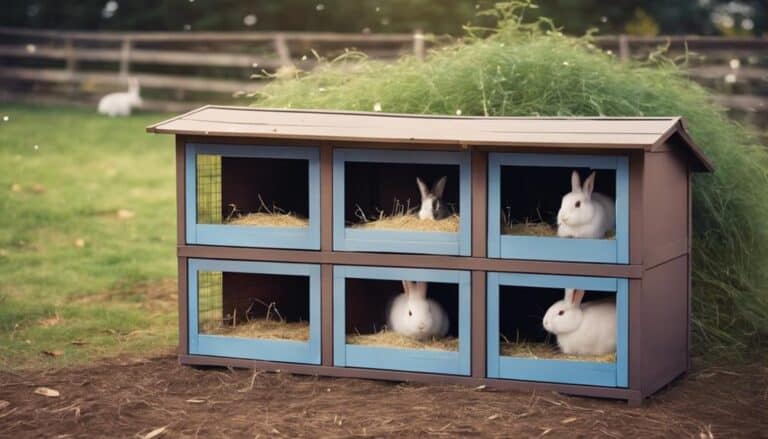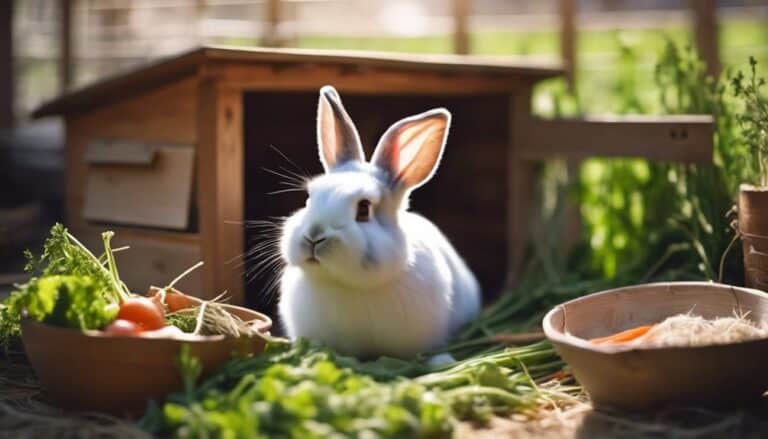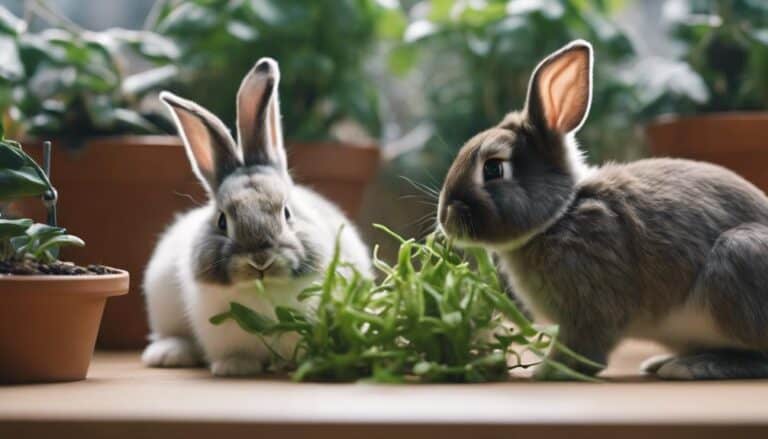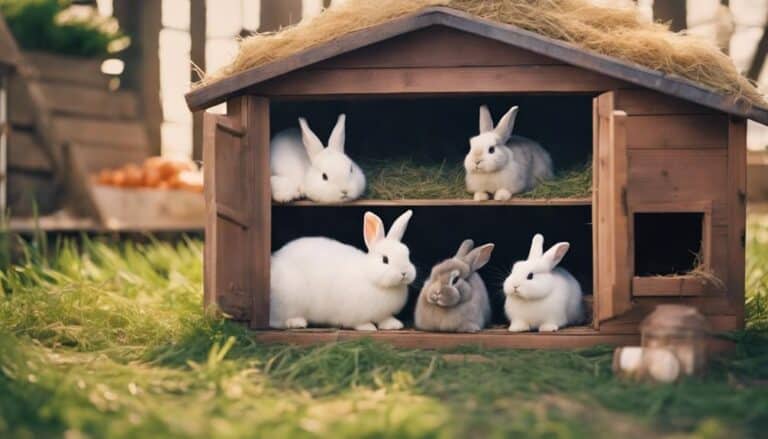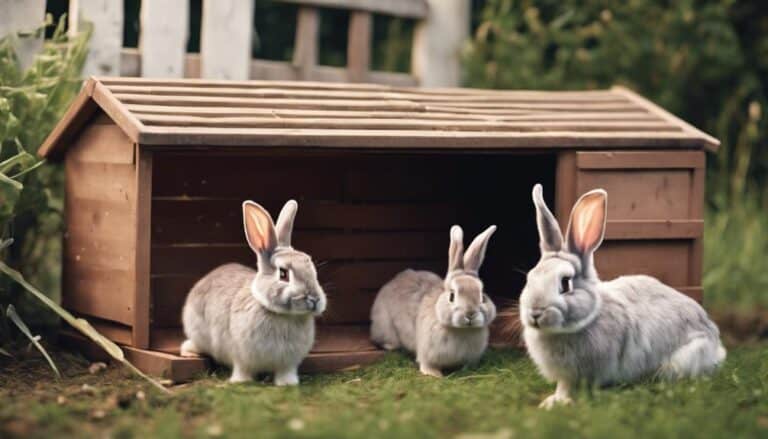When it comes to successful bunny breeding, you might be surprised by the critical role that proper breeding schedules and timing play in the process. The timing of breeding can have a major impact on the success of your endeavors, but there's more to the equation.
Understanding the nuances of breeding pairs and making sure the right techniques are used during mating are just the beginning of what it takes to guarantee successful bunny breeding.
So, what other factors should you keep in mind to increase your chances of success in this intricate process?
Contents
Key Takeaways
- Precise breeding management schedules optimize fertility and health for successful bunny breeding.
- Pairing rabbits with complementary genetics and traits ensures desirable and healthy offspring.
- Monitoring, care, and prompt issue resolution are crucial for enhancing breeding success rates.
- Detailed record-keeping, data analysis, and attention to nutrition, health, and environment are key for successful bunny breeding programs.
Breeding Schedule and Timing

When planning successful bunny breeding, adhering to a precise breeding schedule and timing is paramount to secure superior reproductive outcomes. A recommended breeding schedule involves rebreeding does 14 to 21 days after kindling, ensuring that the does have adequate recovery time and are in best condition for mating again. Commercial producers often opt for a 35-day breed-back schedule, which enhances breeding efficiency and allows for a more streamlined production process.
Checking the fertility of rabbits before mating is critical to prevent any potential issues that could arise from inadequate health or reproductive conditions. Timing is key when mating multiple does on the same day, as it can facilitate fostering if needed, providing a practical solution for commercial producers managing larger breeding operations.
Selecting Ideal Breeding Pairs
When selecting ideal breeding pairs for your rabbits, consider pairing complementary traits to enhance desirable characteristics in offspring.
Assure genetic diversity by choosing rabbits with distinct bloodlines to reduce the risk of hereditary health issues.
Assess the health and compatibility of potential pairs to increase the chances of successful breeding outcomes.
Pairing Complementary Traits
To confirm successful bunny breeding outcomes, carefully pair rabbits with complementary traits that encompass physical characteristics, temperament, and genetic qualities. When selecting breeding pairs, focus on traits like fur color, body size, ear shape, and overall conformation to make sure offspring conform to desired standards.
By considering genetic diversity in breeding pairs, you can reduce the risk of inherited health issues and strengthen the gene pool. Balanced pairing of rabbits with strengths in different areas can lead to improved offspring quality and overall breeding success.
Remember that matching complementary traits in breeding pairs is vital for establishing a foundation of excellence in your breeding program, laying the groundwork for healthy, thriving bunnies with desirable characteristics.
Ensuring Genetic Diversity
When selecting ideal breeding pairs to guarantee genetic diversity in your bunny breeding program, prioritize rabbits with diverse genetic backgrounds to prevent inbreeding depression and promote overall herd vitality. Consider various genetic traits such as color, size, temperament, and health when pairing rabbits to achieve a balanced combination in the offspring.
Genetic diversity not only enhances herd vitality but also reduces the risk of genetic disorders, ensuring healthier breeding outcomes. Aim for strategic pairings that bring together different genetic backgrounds to maintain diversity within the herd.
Regularly assess and rotate breeding pairs to continuously improve genetic diversity and enhance the quality of your breeding program. This approach will contribute to the long-term success and sustainability of your bunny breeding efforts.
Health and Compatibility
Selecting ideal breeding pairs for your bunny breeding program involves making sure both rabbits have a history of good health and evaluating their compatibility based on temperament and behavior. It's important to choose rabbits with good health histories to promote the birth of healthy offspring.
Additionally, consider the genetic diversity of the breeding pairs to prevent potential inbreeding issues. Look for rabbits with desirable traits such as size, fur quality, and coloration, as these characteristics can be passed down to the next generation.
Before pairing rabbits, make sure that both the male and female are in best breeding condition. By evaluating compatibility and health status, you can create the best environment for successful bunny breeding.
Ensuring Proper Mating Techniques
When mating rabbits, it's important to select the right pair and time the mating appropriately.
Ensuring that both the doe and buck are receptive and ready can greatly increase breeding success.
Recording mating dates and assisting when necessary are key steps to optimizing fertility and achieving successful breeding outcomes.
Mating Pair Selection
To guarantee successful bunny breeding, carefully assess mating pairs based on breed standards, temperament, and health for peak genetic diversity and offspring vigor.
When selecting rabbits for mating, consider their compatibility and fertility history to increase the chances of successful copulation.
Monitoring mating behavior is vital to make sure that the rabbits are mating without any issues or aggression.
Providing a stress-free environment is essential to encourage natural breeding behaviors in the mating pair.
Seek advice from experienced breeders or veterinarians if you encounter any mating challenges or concerns, as they can offer valuable insights and solutions to help you navigate the breeding process effectively.
Timing of Mating
Determining the best timing for mating plays a key role in ensuring successful breeding outcomes for your rabbits. When breeding bucks, consider mating during cooler hours in the male's cage as ideal conditions can enhance success rates.
Recording mating dates is important for tracking breeding progress and preparing for kindling. To guarantee fertility levels, allow a one-day delay between mating acts for bucks. Second ejaculations often contain more sperm, increasing the chances of successful breeding.
Checking the doe's receptivity through her vulva color helps determine the perfect timing for mating. By following these breeding techniques and understanding the mating process, you can guarantee a higher likelihood of successful breeding outcomes for your rabbits.
Monitoring Pregnancy and Birth Preparation
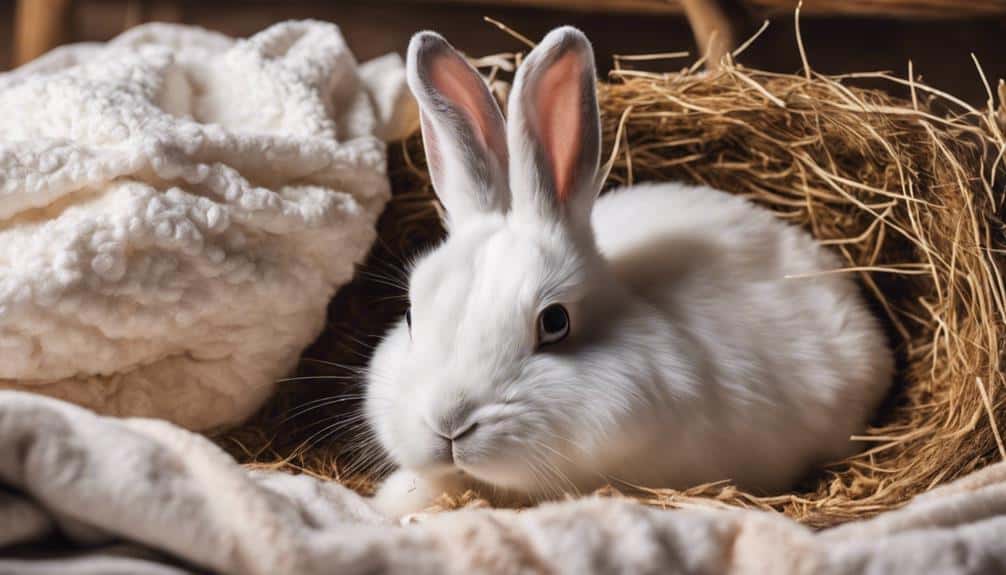
To monitor the progression of pregnancy and prepare for birth with your rabbits, observe the signs of impending labor such as the placement of a nest box in the doe's cage by day 26. Gestation in rabbits typically lasts 28-34 days, so placing the nest box around day 26 guarantees the doe has a safe space for birthing.
Monitoring the nest box for any movement can indicate impending birth, allowing you to be ready. Once the kits are born, checking the nest box within the first 24 hours is vital for evaluating the kits' safety and making sure they're warm and nursing.
Additionally, observing the mother rabbit's behavior post-birth is crucial for evaluating the well-being of the newborn kits. Pay attention to how the mother cares for her young and make sure she's providing them with warmth and milk. This thorough approach to monitoring pregnancy and birth preparation will help make sure the successful breeding of your rabbits.
Post-Breeding Care and Management
In the post-breeding period, ensuring the gentle handling of newborn kits is important to maintain the mother's well-being and reduce stress. Kits should be nursed twice a day for short periods to make certain they receive proper nutrition. Monitoring the health and growth of kits is vital during this phase of the breeding program.
It's crucial to avoid disrupting the bonding process between the mother and her kits as it contributes to their overall well-being. Providing a clean and safe environment for the kits is paramount for their development. Regular kit health monitoring is necessary to address any issues promptly.
Handling newborn kits with care not only benefits the kits but also fosters a positive environment for the mother. By prioritizing nutrition, bonding, and a safe environment, you can ensure the successful post-breeding care and management of your bunny breeding program.
Record-Keeping and Monitoring Progress
After ensuring proper post-breeding care and management for your bunnies, the next step in maintaining a successful breeding program is meticulous record-keeping and progress monitoring.
- Detailed Records: Keeping thorough records of mating dates, behaviors, and outcomes is vital for monitoring breeding progress and identifying patterns.
- Doe Receptivity and Fertility: Record-keeping helps track doe receptivity, breeding frequency, and potential fertility issues, enabling adjustments in breeding strategies.
- Successful Matings and Pregnancies: Monitoring progress allows for tracking successful matings and pregnancies, aiding in predicting future breeding success.
- Breeding Program Optimization: Regularly reviewing breeding records enables the identification of trends, areas for improvement, and necessary adjustments in the breeding program.
Frequently Asked Questions
How Do You Breed a Successful Rabbit?
To breed a successful rabbit, create a conducive breeding environment, meet nutrition needs, pair rabbits thoughtfully, conduct health checks, adhere to a proper breeding schedule, consider genetics, handle stress, monitor mating behavior, and track pregnancy progress.
What Are the Qualities of a Good Rabbit Breeding?
To cultivate a successful rabbit breeding program, focus on genetic selection, proper housing, nutritional balance, health monitoring, breeding pairs, age consideration, mating behavior, breeding schedule, and record keeping. It's akin to crafting a harmonious symphony of genetics.
How Do You Know if a Rabbit Is Successful Mating?
To know if a rabbit has successfully mated, observe mating behavior, look for signs like pelvic thrusting and acceptance posture, monitor for at least 5-10 minutes, and watch for post-mating behaviors such as grooming or eating, indicating satisfaction.
How Can I Increase My Rabbits Fertility?
To increase your rabbit's fertility, focus on providing appropriate nutritional supplements, considering the breeding season, optimizing environmental conditions, promoting genetic diversity, utilizing hormone therapy, monitoring age factors, conducting regular health checks, mastering proper mating techniques, and managing stress effectively.
Conclusion
To guarantee successful bunny breeding, remember to maintain a strict breeding schedule. Carefully select ideal breeding pairs and guarantee proper mating techniques. Monitor pregnancy and birth preparation, provide post-breeding care, and keep detailed records.
For example, by following these steps, a breeder was able to successfully pair a young, healthy doe with an experienced buck, resulting in a litter of healthy and vibrant kits. By following best practices, you can increase your chances of breeding success and produce high-quality rabbits.


